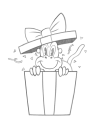$97.75
$115
You save $17.25
DOWNLOADS
project-proportions.mp4
60 MB
project-proportions-transcript-english.txt
1 kB
project-proportions-transcript-spanish.txt
1 kB
project-proportions-captions-english.srt
2 kB
project-proportions-captions-spanish.srt
2 kB
ASSIGNMENTS
Use what you learned to create your own proportion chart.
- Mark Out Your 8 Sections:
Make a chart dividing the figure into eight equal parts, from the head to the pelvis. - Detail Upper Body:
Divide the upper sections into thirds to accurately place the rib cage. - Add Main Body Parts:
Draw the head, rib cage, and pelvis, considering how they align with the spine. - Sketch Limb Positions:
Outline the legs with simple lines to show their direction.
Deadline - submit by Feb 16, 2025 for a chance to be in the critique video!
Here’s my attempt. Next time I need the width between what I drew for the front and back views.
hello this is my first attempt, so a lot of critical mistakes. But I'm happy to improve and not get caught up with perfectionism.
Here's my proportion sketch. I played with 3/4 views, and a few other things like little toy scapulas holding the ball at the top of the arm, the front opening of the ribcage, etc.
Hi everyone. Here is my attempt at the assignment. I simplified it even more, for example the legs in the front view, to make it faster and easier to remember. My biggest doubts are about the side view. Is the curve of the spine correct, or should it be a bit more pronounced? I will come back to this exercise from time to time and add a bit more detail.
First attempt, I naively started out mapping the proportions without a ruler, but the lines ended up being insanely wobbly as I was using a fineliner and not a pencil and was scared of missing the mark haha. Will probably redo this more accurately again.
I'm not sure how some of the proportions turned out, or if the legs turned out too long.
So I'd appreciate it if anyone could correct my mistakes.
Distance between sections is off slightly, which will skew all proportions. When making a chart/diagram that you’re going to use for study and reference, don’t be afraid to measure with a ruler. Overall I think you still managed to make it pretty dang close. So good job 👍👍
Finally got time to draw
Wondering how to decide the width of the head? Like how wide compares to the height
Depends on the specific person of course, but the sort of "standard" I've seen is 2/3 of the height. So you start with a square (or circle), then you take half of that square and add it to the bottom for the chin / jaw.





